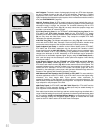
46
Storage and Transport
When the telescope is not in use, store it in a cool, dry place. Do not expose the
instrument to excessive heat or moisture. It is best to store the telescope in its
original box with the vertical and horizontal locks (6 and 9, Fig. 1) in the unlocked
positions. If shipping the telescope, use the original box and packing material to
protect the telescope during shipment.
When transporting the telescope, take care not to bump or drop the instrument; this
type of abuse can damage the optical tube and/or the objective lens and knock the
optics out of alignment. It is highly recommended to use an optional carry case to
transport the telescope (see
OPTIONAL ACCESSORIES, page 43).
Inspecting the Optics
A few words about the so-called “Flashlight Test:" If a flashlight or other
high-intensity light source is pointed down the main telescope tube, the view
(depending upon the observer’s line of sight and the angle of the light) may reveal
what appear to be scratches, dark or bright spots or uneven coatings, giving the
appearance of poor quality optics. These effects are only seen when a high intensity
light is transmitted through lenses or reflected off the mirrors and can be seen on any
high-quality optical system, including giant research telescopes.
The optical quality of a telescope cannot be judged by the “flashlight” test; the true test
of optical quality can only be conducted through careful star testing.
Troubleshooting
The following suggestions may be helpful with operation of the ETX-90AT,
ETX-105AT and ETX-125AT.
The power indicator light on the telescope does not come on or there is no
response when pressing the Autostar Arrow keys:
• Verify that the Computer Control panel power switch (A, Fig. 2) is in the ON
position.
• Verify that the Autostar coil cord is firmly connected to the HBX port (
C, Fig. 2).
• If using internal power (batteries), verify that the batteries are installed correctly and
that they have sufficient charge (see
HOW TO ASSEMBLE YOUR TELESCOPE AND
TRIPOD, page 12).
Note: If the batteries are getting low on charge, there will be a marked
difference in the slew speed. The speed indicator lights may also flash and
the speed may change. If any of these symptoms occurs, turn the power off
and replace the batteries.
• If using an external power source, verify that it is properly connected between the
12-volt connector (
D, Fig. 3) and either a wall plug (AC source) or a car cigarette
lighter (DC source).
• If Autostar does not respond to commands, move the power switch to OFF and then
back to ON.
• If the telescope does not slew after power is applied or if the motor quits or stalls,
verify that there are no physical obstructions that would impede telescope
movement.
• If all physical obstacles are removed and the telescope still does not move
properly, turn off the power and unplug Autostar. Plug Autostar back in and turn the
power back on.
Unable to see an image through the eyepiece:
• Confirm that the lens cover has been removed from the telescope.
• Confirm that the flip-mirror control (
14, Fig. 1) is in the “up” position if using the
eyepiece holder (
4, Fig. 1) so that light is directed to the eyepiece (1, Fig. 1).
Confirm that the flip-mirror control is in the “down” position if using the #932
Erecting Prism or doing photography with an ETX model (see
TELESCOPE
FEATURES, page 6 and PHOTOGRAPHY, page 40).


















